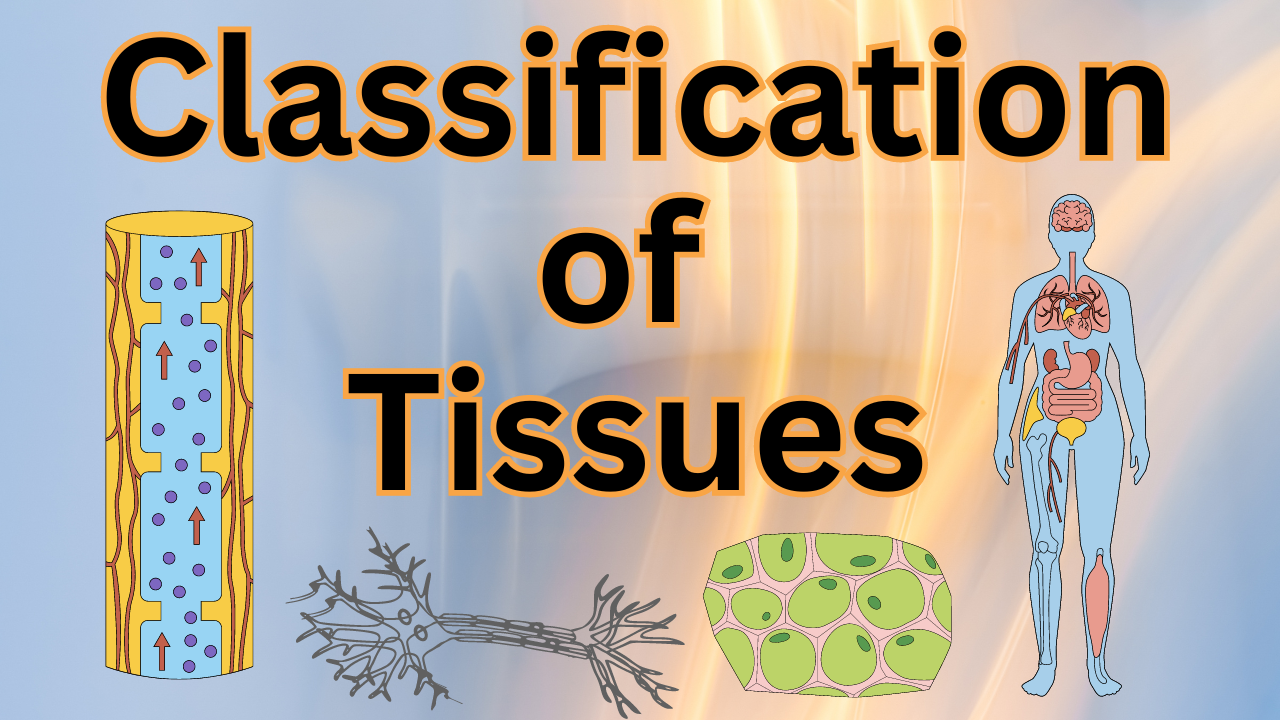Classification of Tissues
Tissues are groups of cells that work together to perform a specific function in the body. In human anatomy and physiology, tissues are crucial for the structural and functional organization of organs and organ systems. The study of tissues, known as histology, helps us understand how different cell types combine to form tissues, and how these tissues contribute to the overall physiology of the body.
There are four primary types of tissues in the human body:
- Epithelial tissue
- Connective tissue
- Muscle tissue
- Nervous tissue
This post will provide an in-depth classification and exploration of these tissue types, highlighting their characteristics, subtypes, locations, and functions.
Epithelial Tissue
Definition
Epithelial tissue consists of tightly packed cells that form continuous sheets. These tissues cover the body surfaces, line internal organs and cavities, and form glands. The main function of epithelial tissue is to act as a protective barrier, control permeability, and provide secretion and absorption functions.
Characteristics of Epithelial Tissue
- Cellularity: Epithelial tissue is made up of tightly packed cells with minimal extracellular matrix.
- Polarity: The tissue has an apical surface (exposed to the external environment or a body cavity) and a basal surface (attached to a basement membrane).
- Avascular: Epithelial tissue lacks blood vessels and is nourished by diffusion from underlying connective tissues.
- Regeneration: Epithelial cells have a high regenerative capacity due to frequent cell division.
Classification of Epithelial Tissue
Epithelial tissue can be classified based on the number of cell layers and the shape of the cells.
Based on Cell Layers
- Simple Epithelium: A single layer of cells that facilitates diffusion, osmosis, filtration, secretion, or absorption.
- Stratified Epithelium: Multiple layers of cells that provide protection in areas of high wear and tear.
- Pseudostratified Epithelium: Appears to have multiple layers, but all cells are attached to the basement membrane, with varying heights.
Based on Cell Shape
- Squamous: Flattened, thin cells that allow for rapid diffusion (e.g., alveoli in the lungs).
- Cuboidal: Cube-shaped cells that are involved in secretion and absorption (e.g., kidney tubules).
- Columnar: Tall, column-like cells involved in absorption and secretion (e.g., lining of the intestines).
Subtypes of Epithelial Tissue
- Simple Squamous Epithelium
- Location: Lining of blood vessels, alveoli, and kidney glomeruli
- Function: Facilitates diffusion and filtration
- Simple Cuboidal Epithelium
- Location: Glandular ducts, kidney tubules, and thyroid follicles
- Function: Secretion and absorption
- Simple Columnar Epithelium
- Location: Digestive tract lining, gallbladder, and uterus
- Function: Absorption and secretion; often has microvilli
- Stratified Squamous Epithelium
- Location: Skin (keratinized), mouth, esophagus, vagina (non-keratinized)
- Function: Protection from abrasion
- Stratified Cuboidal Epithelium
- Location: Sweat gland ducts, mammary glands, salivary glands
- Function: Protection and secretion
- Pseudostratified Columnar Epithelium
- Location: Respiratory tract (trachea, bronchi)
- Function: Secretion and movement of mucus (cilia present)
- Transitional Epithelium
- Location: Urinary bladder, ureters, and urethra
- Function: Stretching and distension
Functions of Epithelial Tissue
- Protection: Protects underlying tissues from physical and chemical injury.
- Absorption: Absorbs nutrients, gases, and other substances (e.g., intestinal lining).
- Secretion: Secretes hormones, enzymes, mucus, and other substances (e.g., glands).
- Excretion: Facilitates waste removal (e.g., sweat glands).
- Filtration: Filters substances (e.g., kidney glomeruli).
Connective Tissue
Definition
Connective tissue is the most abundant and widely distributed tissue in the body. It primarily functions to support, bind, and protect other tissues and organs. Connective tissue is characterized by an extensive extracellular matrix, which can vary in composition to provide different mechanical properties.
Characteristics of Connective Tissue
- Abundance of Extracellular Matrix: Connective tissue consists of cells embedded in a matrix composed of protein fibers (collagen, elastin) and ground substance.
- Vascularity: Most connective tissues have a good blood supply, except for cartilage, which is avascular.
- Diverse Cell Types: The cells within connective tissue include fibroblasts (produce fibers), adipocytes (store fat), chondrocytes (form cartilage), and osteocytes (form bone).
Classification of Connective Tissue
Connective tissue can be classified into three main categories based on the composition and function of the extracellular matrix:
- Connective Tissue Proper
- Supporting Connective Tissue
- Fluid Connective Tissue
1. Connective Tissue Proper
Loose Connective Tissue
- Areolar Tissue:
- Location: Beneath the skin, surrounding organs
- Function: Binds tissues together and provides flexibility
- Adipose Tissue:
- Location: Subcutaneous fat, around organs
- Function: Stores energy, insulates, and cushions organs
- Reticular Tissue:
- Location: Spleen, lymph nodes, bone marrow
- Function: Forms the stroma (supportive framework) of organs
Dense Connective Tissue
- Dense Regular Connective Tissue:
- Location: Tendons, ligaments
- Function: Provides strength and resistance to tension in one direction
- Dense Irregular Connective Tissue:
- Location: Dermis of the skin, fibrous capsules of organs
- Function: Provides strength and resistance to tension in multiple directions
- Elastic Connective Tissue:
- Location: Large blood vessels (e.g., aorta), bronchial tubes
- Function: Allows tissue to recoil after stretching
2. Supporting Connective Tissue
Cartilage
- Hyaline Cartilage:
- Location: Nose, trachea, larynx, ends of long bones
- Function: Provides support and flexibility; resists compressive forces
- Elastic Cartilage:
- Location: External ear, epiglottis
- Function: Provides strength and elasticity
- Fibrocartilage:
- Location: Intervertebral discs, pubic symphysis, menisci of knee
- Function: Provides tensile strength and absorbs compressive shock
Bone
- Compact Bone:
- Location: Outer layers of bones
- Function: Provides structural support and protection; stores calcium
- Spongy Bone:
- Location: Inside bones, particularly at the ends of long bones
- Function: Contains red marrow for blood cell production; provides lightweight support
3. Fluid Connective Tissue
Blood
- Location: Circulates through the cardiovascular system
- Function: Transports oxygen, nutrients, waste products, and immune cells throughout the body
Lymph
- Location: Lymphatic vessels
- Function: Returns interstitial fluid to the bloodstream and participates in immune defense
Functions of Connective Tissue
- Support: Provides structural support to organs and tissues (e.g., bones).
- Protection: Protects delicate organs (e.g., adipose tissue around kidneys).
- Transport: Blood transports nutrients, gases, and waste products.
- Storage: Stores energy in the form of fat (adipose tissue) and minerals (bones).
- Immune Defense: White blood cells in connective tissues defend the body against pathogens.
Muscle Tissue
Definition
Muscle tissue is specialized for contraction and movement. It consists of elongated cells called muscle fibers that are capable of generating force. Muscle tissue plays a vital role in locomotion, posture, and the movement of substances within the body.
Characteristics of Muscle Tissue
- Excitability: Muscle cells respond to electrical stimuli.
- Contractility: Muscle fibers shorten to produce force.
- Elasticity: Muscle tissue can return to its original shape after stretching.
- Extensibility: Muscle fibers can be stretched beyond their resting length.
Types of Muscle Tissue
- Skeletal Muscle
- Cardiac Muscle
- Smooth Muscle
1. Skeletal Muscle
- Location: Attached to bones by tendons
- Structure: Long, cylindrical, multinucleated cells with striations (striped appearance)
- Function: Voluntary movement, posture, and heat production
- Control: Voluntary (under conscious control)
2. Cardiac Muscle
- Location: Walls of the heart (myocardium)
- Structure: Branched cells with a single nucleus, striated, connected by intercalated discs (which facilitate the synchronized contraction of cardiac muscle by allowing rapid transmission of electrical impulses between cells)
- Function: Pumps blood throughout the body by contracting the heart in a coordinated manner
- Control: Involuntary (not under conscious control)
Cardiac muscle tissue is highly specialized to sustain continuous contractions throughout life without fatigue. The intercalated discs are unique to cardiac muscle and ensure that the heart muscle cells contract as a unit, enabling efficient blood flow.
3. Smooth Muscle
- Location: Walls of hollow organs such as the stomach, intestines, bladder, blood vessels, and airways
- Structure: Spindle-shaped cells with a single nucleus, no visible striations
- Function: Controls slow, involuntary movements such as peristalsis in the digestive tract, constriction of blood vessels, and emptying of the bladder
- Control: Involuntary (regulated by the autonomic nervous system)
Smooth muscle cells contract slowly and can sustain prolonged contractions, which are essential for maintaining the functions of internal organs. They also regulate the diameter of blood vessels and the movement of materials through the digestive system.
Functions of Muscle Tissue
- Movement: Skeletal muscles generate voluntary body movements, such as walking and lifting objects.
- Circulation: Cardiac muscle pumps blood throughout the body.
- Digestion: Smooth muscle moves food through the digestive tract and regulates the flow of substances through organs like the bladder and intestines.
- Posture: Skeletal muscles maintain body posture and stabilize joints.
- Heat Production: Muscle contractions generate heat, which helps maintain body temperature.
Nervous Tissue
Definition
Nervous tissue is specialized for communication and control of bodily functions. It is composed of neurons, which transmit electrical impulses, and glial cells, which provide support and nourishment to neurons. Nervous tissue is responsible for receiving sensory input, integrating information, and coordinating responses.
Characteristics of Nervous Tissue
- Excitability: Neurons are capable of responding to stimuli and generating electrical signals.
- Conductivity: Neurons can transmit these electrical signals over long distances within the body.
- Support: Glial cells support the structure and function of neurons.
Structure of Nervous Tissue
Nervous tissue consists of two main cell types:
- Neurons: The functional units of the nervous system responsible for transmitting electrical signals. Neurons have three main parts:
- Cell body (soma): Contains the nucleus and cytoplasm.
- Dendrites: Short, branched extensions that receive signals from other neurons.
- Axon: A long extension that transmits electrical signals to other neurons or effector cells (muscles or glands).
- Glial Cells: These are non-excitable cells that support, protect, and nourish neurons. There are several types of glial cells, including:
- Astrocytes: Provide structural support and regulate the blood-brain barrier.
- Oligodendrocytes: Form myelin sheaths around axons in the central nervous system (CNS).
- Schwann Cells: Form myelin sheaths around axons in the peripheral nervous system (PNS).
- Microglia: Act as the immune cells of the CNS, cleaning up debris and protecting against infections.
Functions of Nervous Tissue
- Sensory Input: Neurons detect stimuli from the external and internal environments (e.g., touch, temperature, sound).
- Integration: The central nervous system (brain and spinal cord) processes and interprets sensory input, creating responses based on that information.
- Motor Output: Neurons transmit signals to muscles and glands to produce responses, such as movement or hormone secretion.
- Homeostasis: The nervous system helps maintain the internal balance of the body by regulating processes such as breathing, heartbeat, and digestion.
Tissue Repair and Regeneration
Tissue repair is a critical process in maintaining the health and integrity of the body. The ability of tissues to repair themselves after injury varies depending on the tissue type and the severity of the injury.
Phases of Tissue Repair
- Inflammation: The body’s initial response to tissue injury involves the release of inflammatory chemicals, which cause blood vessels to dilate, bringing in immune cells and nutrients to the site of injury.
- Proliferation: New tissue is formed by the proliferation of cells. For some tissues, such as the epithelium, cells can rapidly regenerate to replace damaged ones.
- Remodeling: The final phase involves the maturation and reorganization of new tissue. Scar tissue, composed of collagen fibers, may form in some tissues, such as the skin and muscles.
Tissue Regeneration Capacity
- High regenerative capacity: Epithelial tissues, such as the skin and digestive tract lining, have a high capacity for regeneration.
- Moderate regenerative capacity: Smooth muscle and dense connective tissue (e.g., tendons and ligaments) have a limited capacity for repair but can regenerate under certain conditions.
- Low regenerative capacity: Cardiac muscle and nervous tissue have very limited regenerative abilities. Damage to these tissues often results in permanent functional loss (e.g., in heart attacks or spinal cord injuries).
Factors Affecting Tissue Repair
- Age: Younger individuals typically have faster tissue repair rates compared to older individuals.
- Nutritional Status: Adequate nutrition, especially protein, vitamins (A, C), and minerals (zinc), is essential for proper tissue repair.
- Blood Supply: Tissues with a good blood supply (e.g., skin, muscles) tend to repair more quickly than tissues with poor blood supply (e.g., cartilage).
- Infection: Infections can delay tissue repair by introducing pathogens that interfere with the healing process.
Understanding the classification and functions of tissues in human anatomy and physiology is crucial for grasping how the body operates as a cohesive unit. Each of the four main tissue types—epithelial, connective, muscle, and nervous—plays a unique role in maintaining the structure, function, and homeostasis of the body.
- Epithelial tissue forms protective barriers and is involved in absorption, secretion, and excretion.
- Connective tissue provides structural support, stores nutrients, and participates in immune defense.
- Muscle tissue is responsible for movement, posture, and heat production.
- Nervous tissue facilitates communication and control within the body.
The study of these tissues not only highlights their individual importance but also their interconnectedness in ensuring the body’s proper functioning. Tissue repair and regeneration further emphasize the dynamic nature of these tissues and their role in maintaining health and wellness.
MORE : Tissues of the Human Body
<<<<<<<<<<<<JOIN US>>>>>>>>>>>>>>>>
| Subscribe our PHARMACY INDIA YouTube Channel for more Pharma Updates | Click Here |
| Follow us on Instagram | Click Here |
| Download PHARMACY INDIA MOBILE APP from Google Play Store | Click Here |
| Follow us on LinkedIn | Click Here |






